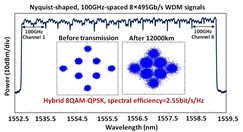PRESS RELEASE
12 March 2013
Contact:
Brielle Day
OFC/NFOEC
202.416.1435
bday@osa.org
OFC/NFOEC Features New Research in Low-Power Supercomputing, Long-Distance 400G Data Transmission, Simplified Multicore Fiber Manufacturing
WASHINGTON, March 12, 2013—Next week, leaders from telecom, datacom and computing will convene for the Optical Fiber Communication Conference and Exposition/National Fiber Optic Engineers Conference (
OFC/NFOEC)—the premier optical communications event where experts from industry and academia share their results, experiences, and insights on the future of hot topic areas such as cloud and datacenter networking, software-defined networks, photonic integration and more. More than 12,000 attendees and an exhibit with 550 companies are expected.
The conference features a comprehensive technical program with more than 800 talks covering the latest research related to all aspects of optical communications. Some of the 2013 highlights come from leading companies in the industry including IBM, AT&T and AFL. Selected research presentations taking place at the conference next week and outlined below include:
1.
Ultra-High-Speed Optical Communications Link Sets New Po wer Efficiency Record
2.
New Distance Record for 400 Gb/s Data Transmission
3.
New Automated Process Simplifies Alignment and Splicing of Multicore Optical Fibers
ULTRA-HIGH-SPEED OPTICAL COMMUNICATIONS LINK SETS NEW POWER EFFICIENCY RECORD

Optical link test chips, including transmitter (TX) circuits, laser diodes, photo diode, and receiver (RX) circuits. Image courtesy IBM.Click for a larger image.
Ultrafast supercomputers that operate at speeds 100 times faster than current systems are now one step closer to reality. A team of IBM researchers working on a U.S. Defense Advanced Research Projects Agency (DARPA)-funded program have found a way to transmit massive amounts of data with unprecedentedly low power consumption.
The team will describe their prototype optical link, which shatters the previous power efficiency record at OFC/NFOEC 2013 next week.
Scientists predict that the supercomputers of the future—so-called “exascale computers”—will enable them to model the global climate, run molecular-level simulations of entire cells, design nanostructures, and more. “We envision machines reaching the exascale mark around 2020, but a great deal of research must be done to make this possible,” says Jonathan E. Proesel, a research staff member at the IBM T. J. Watson Research Center in Yorktown Heights, N.Y. To reach that mark, researchers must develop a way to quickly move massive amounts of data within the supercomputer while keeping power consumption in check.
By combining innovative circuits in IBM’s 32-nanometer silicon-on-insulator complementary metal-oxide-semiconductor (SOI CMOS) technology with advanced vertical cavity surface emitting lasers (VCSELs) and photodetectors fabricated by Sumitomo Electric Device Innovations USA (formerly Emcore), Proesel and his colleagues created a power-efficient optical communication link operating at 25 gigabits per second using just 24 milliwatts of total wall-plug power, or 1 pJ/bit. “Compared to our previous work, we have increased the speed by 66 percent while cutting the power in half,” Proesel says. “We’re continuing the push for lower power and higher speed in optical communications. There will always be demand to move more data with less energy, and that’s what we’re working toward.”
Proesel’s presentation at OFC/NFOEC, titled, “35-Gb/s VCSEL-Based Optical Link using 32-nm SOI CMOS Circuits” will take place Monday, March 18 at 2 p.m. in the Anaheim Convention Center.
NEW DISTANCE RECORD FOR 400 GB/S DATA TRANSMISSION
AT&T Labs to report milestone at OFC/NFOEC 2013
 Measured optical spectrum of the eight 100GHz-spaced 495Gb/s WDM signals at the launch into the transmission fiber. The insets are measured constellation diagrams before and after transmission. QPSK: quadrature phase shift keying; QAM: quadrature amplitude modulation; WDM: wavelength division multiplexed. Image courtesy AT&T Labs. Click for a larger image.
Measured optical spectrum of the eight 100GHz-spaced 495Gb/s WDM signals at the launch into the transmission fiber. The insets are measured constellation diagrams before and after transmission. QPSK: quadrature phase shift keying; QAM: quadrature amplitude modulation; WDM: wavelength division multiplexed. Image courtesy AT&T Labs. Click for a larger image.
As network carriers debate the next Ethernet standard—and whether transmission speeds of 400 gigabit per second or 1 terabit per second should be the norm—engineers are working on new measures to squeeze next-generation performance out of current-generation systems.
To that end, a team from AT&T has devised a new patent pending technique enabling tuning of the modulation spectral efficiency, which allows, for the first time, 400 Gb/s signals to be sent over today’s 100 gigahertz-grid optical networks over ultra-long distances. Spectral efficiency is the information rate that can be transmitted over a given bandwidth, and measures how efficiently the available frequency spectrum is utilized.
The researchers, led by optical transmission system expert Xiang Zhou of AT&T Labs-Research in Middletown, N.J., will describe their work next week at OFC/NFOEC 2013.
In the system, Nyquist-shaped 400Gb/s signals with tunable spectral efficiency were generated using modulated subcarriers. Eight 100 GHz-spaced, 400 Gb/s wavelength-division-multiplexed signals were combined and then transmitted over a re-circulating transmission test platform consisting of 100-km fiber spans.
Using the new modulation technique and a new low-loss, large-effective area fiber from OFS Labs, the team transmitted the signals over a record-breaking 12,000 kilometers (roughly 7500 miles)—surpassing their own previous distance record (using the 50 gigahertz-grid) by more than 9000 km.
“This result not only represents a reach increase by a factor of 2.5 for 100 GHz-spaced 400 G-class WDM systems, it also sets a new record for the product of spectral efficiency and distance,” says Zhou. Compared to modulation techniques currently used, he says, “our method has the unique capability to allow tuning of the modulation spectral efficiency to match the available channel bandwidth and maximize the transmission reach, while maintaining tolerance to fiber nonlinearities and laser phase noise, both of which are major factors limiting performance for high-speed optical systems.”
Zhou’s presentation at OFC/NFOEC, entitled “12,000km Transmission of 100GHz Spaced, 8x495-Gb/s PDM Time-Domain Hybrid QPSK-8QAM Signals,” will take place Tuesday, March 19 at 3 p.m. in the Anaheim Convention Center.
NEW AUTOMATED PROCESS SIMPLIFIES ALIGNMENT AND SPLICING OF MULTICORE OPTICAL FIBERS
Technique reported at OFC/NFOEC 2013 takes splicing out of the lab, into the production line

The Fujikura FSM-100P+ fusion splicer is used for the automated alignment and splicing of MCF with PC control software developed by AFL. Image courtesy Fujikura Splicer Department.Click for a larger image.
New multicore optical fibers have many times the signal-carrying capacity of traditional single-core fibers, but their use in telecommunications has been severely restricted because of the challenge in splicing them together-- picture trying to match up and connect two separate boxes of spaghetti so that all of the noodles in each box are perfectly aligned. Now, a new splicing technique offers an automated way to do just that, with minimal losses in signal quality across the spliced sections. The method will be described next week at OFC/NFOEC 2013.
In the telecommunications industry, engineers maximize signal-carrying capacity using a process called multiplexing, which allows multiple signals or data streams to be combined within a single fiber cable. One digital phone line, for example, uses 64 kilobits per second of bandwidth, but with a technique called time multiplexing, more than 1.5 million phone conversations can take place at the same time, carried by one fiber core. With wavelength multiplexing, that one fiber core can send up to 200 different wavelengths of light simultaneously, increasing the capacity to 10 terabits per second, serving about 200 million phone lines. Those multiplexed fibers, in turn, can be bundled together into a so-called multicore fiber (MCF), consisting of up to 19 cores—and up to 19 times the signal-carrying capacity.
The challenge, however, is splicing those multicores together.
Researchers who work with MCFs in the lab usually have their own preferred manual processes for aligning and splicing fibers, explains Wenxin Zheng, manager of splice engineering at
AFL in Duncan, S.C., who developed the new technique. “Although the manual way may be good for a skilled operator in a lab environment for research purposes, automation is the only path that can push MCF to factories and production lines.”
In Zheng’s process, which uses a Fujikura FSM-100P+ fusion splicer (see image), the fibers to be spliced are stripped and loaded into the splicer, then rotated and imaged with two video cameras so that their cores can be roughly aligned using a pattern-matching algorithm. Next, using a power-feedback method and image processing, a pair of corresponding cores in each fiber are finely aligned, as is the cladding around the cores. Finally, the cores are heat-spliced.
“To align the multiple cores simultaneously is a big challenge,” Zheng says. “If two fibers to be spliced have random core locations, there is no way to align the entire core.” However, the component cores of MCFs
can be aligned if they are created using the same design standard, and if the cores are distributed symmetrically in the MCF—such as in a seven-core MCF with one central core surrounded by six cores oriented like the spokes of a wagon wheel. In that case, Zheng notes, “we can fine-align one side-core in an MCF and its cladding at the same time. Based on the geometric specifications of the fiber, the rest of the cores will be automatically aligned.”
Zheng’s presentation, “Automated Alignment and Splicing for Multicore Fibers,” will take place at 5 p.m. Monday, March 18 at the Anaheim Convention Center.
About OFC/NFOEC
For more than 35 years, the Optical Fiber Communication Conference and Exposition/National Fiber Optic Engineers Conference (OFC/NFOEC) has been the premier destination for converging breakthrough research and innovation in telecommunications, optical networking, fiber optics and, recently, datacom and computing. Consistently ranked in the top 200 tradeshows in the United States, and named one of the Fastest Growing Trade Shows in 2012 by TSNN, OFC/NFOEC unites service providers, systems companies, enterprise customers, IT businesses, and component manufacturers, with researchers, engineers, and development teams from around the world. OFC/NFOEC includes dynamic business programming, an exposition of more than 550 companies, and cutting-edge peer-reviewed research that, combined, showcase the trends and pulse of the entire optical communications industry.
OFC/NFOEC is managed by the Optical Society (OSA) and co-sponsored by OSA, the Institute of Electrical and Electronics Engineers/Communications Society (IEEE/ComSoc), and the IEEE Photonics Society. OFC/NFOEC 2013 takes place March 17 – 21 at the Anaheim Convention Center in Anaheim, Calif. For more information, visit
www.ofcnfoec.org.